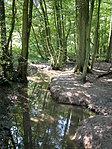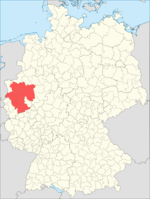Mülheim (Ruhr) West station

Mülheim (Ruhr) West station is located in the German city of Mülheim in the German state of North Rhine-Westphalia. It is on the Witten/Dortmund–Oberhausen/Duisburg line and is classified by Deutsche Bahn as a category 5 station.The station was opened 1 March 1862 by the Bergisch-Märkische Railway Company and was called Mülheim (BM) station until 1892, when it was renamed Mülheim (Ruhr). Although it was larger than the station now known as Mülheim (Ruhr) Hauptbahnhof, it was not accepted as the town's main station, because it was too far from its central area. On 26 May 1974, it was renamed to its current name.It is served by Rhine-Ruhr S-Bahn line S 3 every 30 minutes, tram line 112 (every 10 minutes) operated by Stadtwerke Oberhausen and Mülheimer VerkehrsGesellschaft, and bus line 128 (every 20 minutes) operated by Mülheimer VerkehrsGesellschaft. The former tram line 110 was replaced by bus 128 on 4 October 2015.
Excerpt from the Wikipedia article Mülheim (Ruhr) West station (License: CC BY-SA 3.0, Authors, Images).Mülheim (Ruhr) West station
Friedrich-Ebert-Straße, Mülheim an der Ruhr Eppinghofen (Rechtsruhr-Nord)
Geographical coordinates (GPS) Address Nearby Places Show on map
Geographical coordinates (GPS)
| Latitude | Longitude |
|---|---|
| N 51.439649 ° | E 6.871205 ° |
Address
Mülheim (Ruhr) West
Friedrich-Ebert-Straße
45473 Mülheim an der Ruhr, Eppinghofen (Rechtsruhr-Nord)
North Rhine-Westphalia, Germany
Open on Google Maps









